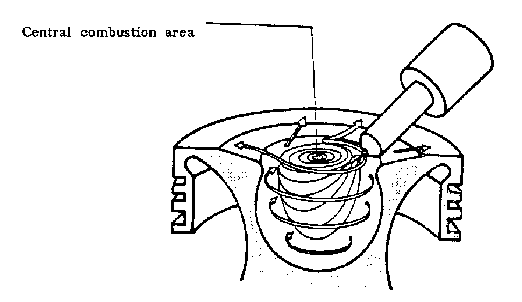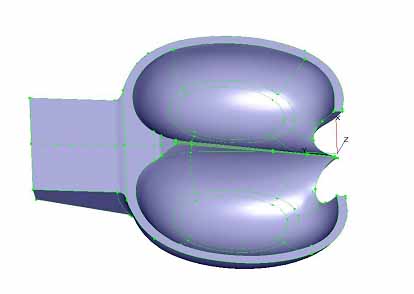docbb
Junior Member
  Back from ZA
Back from ZA
Posts: 92
|
Post by docbb on Aug 28, 2012 23:30:37 GMT -8
Peter do you think the metal part of the "P"channel matters? did I say "plasma"?  Have you seen any change in the iron plate, like transforming into a magnet ? |
|
|
|
Post by peterberg on Aug 29, 2012 1:45:59 GMT -8
Yes, because the plate is getting very hot inside. The result is warming up of the airstream which is going down. The top end of the plate is a bit longer in my case, this will stay relatively cool but a little bit too hot to the touch. The side of the channel which is facing the riser wall shows the colours of heated up steel, bordering at the ceiling of the firebox exactly. But no magnetization as far as I can tell.
|
|
docbb
Junior Member
  Back from ZA
Back from ZA
Posts: 92
|
Post by docbb on Sept 1, 2012 4:37:02 GMT -8
dear Peter, while looking at your video i was thinking if it could be possible to enhance the mixing gases process by shaping the afterbuner chamber, like it is done in combustion chambers in injection diesel engines    Etc, there are plenty of shapes on the Internet by the way, in your "small scale experiment" you used a backward beak at the junction between chamber and riser, this time you didn't, wasn't worth to mold it again ? |
|
docbb
Junior Member
  Back from ZA
Back from ZA
Posts: 92
|
Post by docbb on Sept 1, 2012 5:12:40 GMT -8
or the like the buckets in a Pelton's turbine  |
|
|
|
Post by satamax on Sept 1, 2012 11:53:59 GMT -8
|
|
|
|
Post by peterberg on Sept 2, 2012 12:35:10 GMT -8
while looking at your video i was thinking if it could be possible to enhance the mixing gases process by shaping the afterbuner chamber, like it is done in combustion chambers in injection diesel engines The possibilities of shape are endless. But there's also a point where I will say "this is good enough". My personal goal is one of designing the stove parts as lean as possible, so everybody who like these things can make their own. Of course you are free to take up this challenge and mold your own afterburner chamber. Additionally, you have to buy capable test equipment, otherwise it's impossible to know whether it's an improvement or not. by the way, in your "small scale experiment" you used a backward beak at the junction between chamber and riser, this time you didn't, wasn't worth to mold it again? I think you are referring to the trip wire. In this high and narrow tunnel opening a trip wire doesn't contribute to the quality of the burn. When something isn't needed for a good burn, I'll leave it out. |
|
|
|
Post by peterberg on Sept 3, 2012 8:23:28 GMT -8
The demonstration using the cast parts was done two days ago. The demo itself went well, the stove showed the predicted behavior. However, the two 55 gallon barrels were not enough by far to extract most of the heat production. The improvised chimney generated a very small draft, at first nothing at all and sometimes 0.01 mbar. But the cold start to begin the demo wasn't a problem at all. This was done by lighting a small kindle fire just in front of the tunnel opening. The specific roar of this stove started at about 3 minutes after lighting it, visible smoke disappeared 10 seconds later. After that the stove was filled up successively, taking care of maintaining the sound. During the full burn the front side was closed by some firebricks leaving some 4 square inch open at the lowest level of the firebox.  High res: High res:The average temp of the exhaust gases were about 180 F. lower as compared to most of the other testruns. And yes, the demonstration served as a testrun as well. One single run isn't enough to rely on, but I've sold the thing on the spot to the owner of the place. Here's the graphic:  High res: High res:As can be seen, the fire development was quite even, no large jumps in any of the lines. Nothing outside the temp indicated the presence of another barrel on top, forming a larger bell. Actually, an even larger single bell of three barrels stacked upon each other could be sufficient, maybe. At the very end of the run the CO went up dramatically. The computer wasn't stopped in time to keep the figures comparable with former runs at home. But I was able to amend the averages to the correct end mark: O2 12.8 %, eff. 82.5 %, CO 761 ppm, Tr 181 C. (358 F.). During the evening, some people kept the fire going at a lower rate. As long as the roar went along, there appeared to be no visible smoke. Irrespective of what was thrown in, or so it seems. The largest piece, a 4" x 2" split of ash laid down on a couple of half-burned smaller ones burst into flames without a sign of hesitation. The firebox temperature at that very moment wasn't high, the logs filled it up to about a third.  High res: High res:A hint: it's best to get the paint off before running such a stove inside an inhabited room. About the specific roar: this is a peculiar sound, because it do consist of two quite separated parts. The most obvious one is the roaring of the flames itself, speed of this is fairly constant during the run, only louder when the burn is at its top. When the stove is coming up to temperature another sound is coming in, a sort of irregular bubbling at a lower pitch. |
|
docbb
Junior Member
  Back from ZA
Back from ZA
Posts: 92
|
Post by docbb on Sept 3, 2012 18:08:35 GMT -8
Dear Peter,
on the pictures i can see thar the "fireplace" is almost closed on the first one and completely obtured on the second one except a narrow split in the lower part.
are your last mesurements comparable to your previous ones, according the fact you wrote the "door" was completely open like a fireplace ?
|
|
|
|
Post by peterberg on Sept 4, 2012 2:11:11 GMT -8
are your last mesurements comparable to your previous ones, according the fact you wrote the "door" was completely open like a fireplace ? The results were comparable, yes. But... this afterburner construction without a p-channel is firmly tied to a high gas velocity. Running with a weaker draft due to a minimal chimney stack will result in sub-optimal performance. So, at this stage of development I would say the p-channel and an inlet of 25 cm2 (4 sq.in.) low in the combustion chamber hold the best chance to a successful working stove. One of the attendees of the demonstration happens to be an 11-year old boy who's very interested. On Monday evening, with some help of his dad, during the second attempt he managed to build a batch box which produced the sought after roar. His dad could confirm the clay mortar was still wet and there was no smoke to be seen or to smell at this stage. The first attempt was without a p-channel, to aid the second his dad made him one. Try it for yourself, once the proper roar is sounding you're there. |
|
docbb
Junior Member
  Back from ZA
Back from ZA
Posts: 92
|
Post by docbb on Sept 5, 2012 0:16:41 GMT -8
...well it is far better with a real keyboard and no corrector...
so, il looks to me thet the concrete veriosn is a little narrower than the chamotte version, right? the height/wide ratio seems more like 4:3 and 3:2 respectively.
Does it matter? Is better to builld a "slim" or a "fatty" firebox
Is the ceiling still 10 cm from the upper part of the tunnel in the concrete version?
And, how far do you think we could scale up or down the model as long we keep the proportions ? It will change the volumes in a different way than the surfaces and lenghts (cube, square, linear proportions)
you seem emphase more the c.s.a. ratio than the volumes or lenghts ones.
Last think: how manage the P channel on the long term if the box is completely embended in the middle of an massive building ?
on standby for your thoughts
|
|
|
|
Post by satamax on Sept 6, 2012 23:23:00 GMT -8
Peter, regarding your sketchup file, is the 160x100mm the real internal dimansion of the heat riser?
114cm² aproximately for the opening at the end of the batch box? Did you do the batch box at à particular size? Or is it "brick convenience"?
Thanks a lot.
Max.
|
|
|
|
Post by peterberg on Sept 7, 2012 1:42:08 GMT -8
docbb, Yes, the cast version is narrower. No particular reason, just another brainwave to follow. The space above the tunnel happened to be larger as well, coupled to a longer p-channel. I've changed that after a couple of adequate drying runs. This firebox still showed some smoke spillage on the top of the burn. So, the height/width ratio of 3:2 is definitely the better option. The ceiling of the firebox is 4" or 10 cm from the tunnel again. I honestly don't know how a larger implementation would perform, yet. A builder in the Netherlands is busy building such a larger one, we've had contact quite intensively. In about one or maybe two weeks there are results available, I will post these. The p-channel should be replaceable, you're right about that. No solution to that problem yet.
|
|
|
|
Post by peterberg on Sept 7, 2012 1:54:12 GMT -8
@max,
The internal dimensions are 110x160 mm, resulting in a c.s.a. of 176 cm2. Really close to the 6" equivalent.
The narrow tunnel is about 120 cm2, 70% of the riser c.s.a. As long as you do stick to the ratios and refrain from deviations, the thing will run like mad. Exact measurements aren't convenient, so I am very curious about the 8" version of the commercial builder here.
My implementation is a little bit smaller than canyon's, due to brick sizes.
|
|
docbb
Junior Member
  Back from ZA
Back from ZA
Posts: 92
|
Post by docbb on Sept 7, 2012 4:42:14 GMT -8
well I thought to a solution for the P-channel.
it could be simple to make a vertical rabbet in the mold at the entrance of the active tunnel, may be it's already done, men could insert the metal U piece upward from inside the firebox and then let it lay on a baffle in the rabbet.
|
|
|
|
Post by satamax on Sept 7, 2012 8:51:12 GMT -8
@max, The internal dimensions are 110x160 mm, resulting in a c.s.a. of 176 cm2. Really close to the 6" equivalent. The narrow tunnel is about 120 cm2, 70% of the riser c.s.a. As long as you do stick to the ratios and refrain from deviations, the thing will run like mad. Exact measurements aren't convenient, so I am very curious about the 8" version of the commercial builder here. My implementation is a little bit smaller than canyon's, due to brick sizes. Me doing deviations? Nah never! ;D Peter, two other questions, would increasing the flow speed be beneficial? I'd like to make the entrance into the heat riser tangential, so it spirals instead of "ram horning" ;D Another thought, i wonder if rounding the bricks edges around the "venturi" wouldn't be beneficial too! |
|